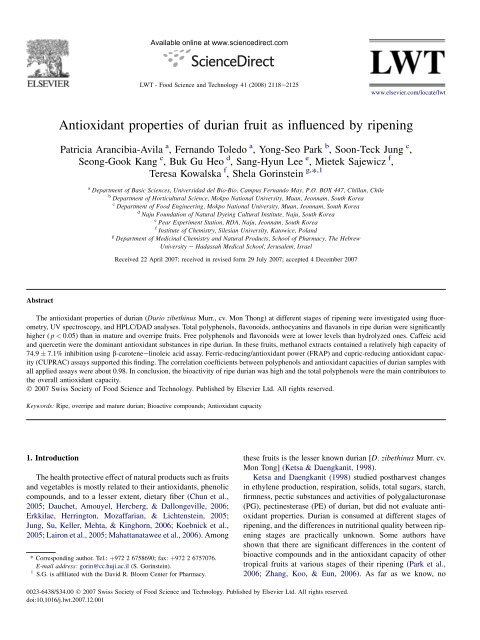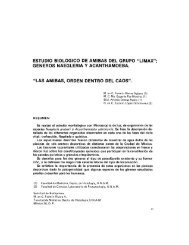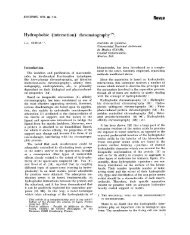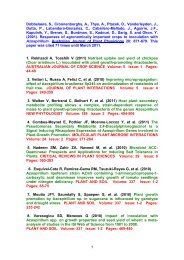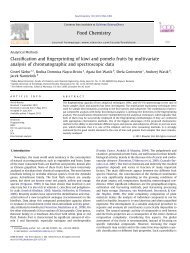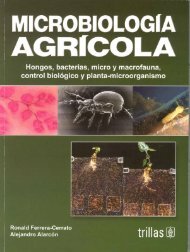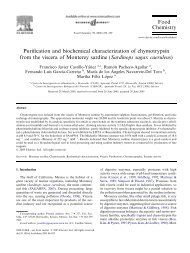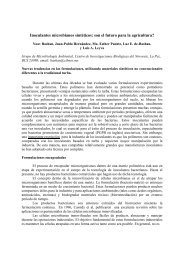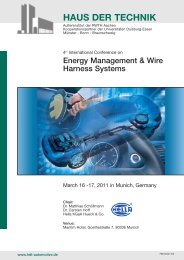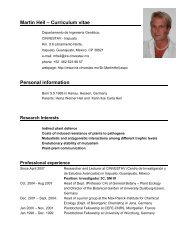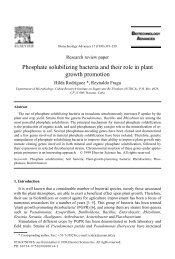Antioxidant properties of durian fruit as ... - bashanfoundation
Antioxidant properties of durian fruit as ... - bashanfoundation
Antioxidant properties of durian fruit as ... - bashanfoundation
You also want an ePaper? Increase the reach of your titles
YUMPU automatically turns print PDFs into web optimized ePapers that Google loves.
Abstract<br />
<strong>Antioxidant</strong> <strong>properties</strong> <strong>of</strong> <strong>durian</strong> <strong>fruit</strong> <strong>as</strong> influenced by ripening<br />
Patricia Arancibia-Avila a , Fernando Toledo a , Yong-Seo Park b , Soon-Teck Jung c ,<br />
Seong-Gook Kang c , Buk Gu Heo d , Sang-Hyun Lee e , Mietek Sajewicz f ,<br />
Teresa Kowalska f , Shela Gorinstein g, * ,1<br />
a Department <strong>of</strong> B<strong>as</strong>ic Sciences, Universidad del Bio-Bio, Campus Fernando May, P.O. BOX 447, Chillan, Chile<br />
b Department <strong>of</strong> Horticultural Science, Mokpo National University, Muan, Jeonnam, South Korea<br />
c Department <strong>of</strong> Food Engineering, Mokpo National University, Muan, Jeonnam, South Korea<br />
d Naju Foundation <strong>of</strong> Natural Dyeing Cultural Institute, Naju, South Korea<br />
e Pear Experiment Station, RDA, Naju, Jeonnam, South Korea<br />
f Institute <strong>of</strong> Chemistry, Silesian University, Katowice, Poland<br />
g Department <strong>of</strong> Medicinal Chemistry and Natural Products, School <strong>of</strong> Pharmacy, The Hebrew<br />
University e Had<strong>as</strong>sah Medical School, Jerusalem, Israel<br />
Received 22 April 2007; received in revised form 29 July 2007; accepted 4 December 2007<br />
The antioxidant <strong>properties</strong> <strong>of</strong> <strong>durian</strong> (Durio zibethinus Murr., cv. Mon Thong) at different stages <strong>of</strong> ripening were investigated using fluorometry,<br />
UV spectroscopy, and HPLC/DAD analyses. Total polyphenols, flavonoids, anthocyanins and flavanols in ripe <strong>durian</strong> were significantly<br />
higher ( p < 0.05) than in mature and overripe <strong>fruit</strong>s. Free polyphenols and flavonoids were at lower levels than hydrolyzed ones. Caffeic acid<br />
and quercetin were the dominant antioxidant substances in ripe <strong>durian</strong>. In these <strong>fruit</strong>s, methanol extracts contained a relatively high capacity <strong>of</strong><br />
74.9 7.1% inhibition using b-caroteneelinoleic acid <strong>as</strong>say. Ferric-reducing/antioxidant power (FRAP) and cupric-reducing antioxidant capacity<br />
(CUPRAC) <strong>as</strong>says supported this finding. The correlation coefficients between polyphenols and antioxidant capacities <strong>of</strong> <strong>durian</strong> samples with<br />
all applied <strong>as</strong>says were about 0.98. In conclusion, the bioactivity <strong>of</strong> ripe <strong>durian</strong> w<strong>as</strong> high and the total polyphenols were the main contributors to<br />
the overall antioxidant capacity.<br />
Ó 2007 Swiss Society <strong>of</strong> Food Science and Technology. Published by Elsevier Ltd. All rights reserved.<br />
Keywords: Ripe, overripe and mature <strong>durian</strong>; Bioactive compounds; <strong>Antioxidant</strong> capacity<br />
1. Introduction<br />
The health protective effect <strong>of</strong> natural products such <strong>as</strong> <strong>fruit</strong>s<br />
and vegetables is mostly related to their antioxidants, phenolic<br />
compounds, and to a lesser extent, dietary fiber (Chun et al.,<br />
2005; Dauchet, Amouyel, Hercberg, & Dallongeville, 2006;<br />
Erkkilae, Herrington, Mozaffarian, & Lichtenstein, 2005;<br />
Jung, Su, Keller, Mehta, & Kinghorn, 2006; Koebnick et al.,<br />
2005; Lairon et al., 2005; Mahattanatawee et al., 2006). Among<br />
* Corresponding author. Tel.: þ972 2 6758690; fax: þ972 2 6757076.<br />
E-mail address: gorin@cc.huji.ac.il (S. Gorinstein).<br />
1 S.G. is affiliated with the David R. Bloom Center for Pharmacy.<br />
Available online at www.sciencedirect.com<br />
LWT - Food Science and Technology 41 (2008) 2118e2125<br />
these <strong>fruit</strong>s is the lesser known <strong>durian</strong> [D. zibethinus Murr. cv.<br />
Mon Tong] (Ketsa & Daengkanit, 1998).<br />
Ketsa and Daengkanit (1998) studied postharvest changes<br />
in ethylene production, respiration, solids, total sugars, starch,<br />
firmness, pectic substances and activities <strong>of</strong> polygalacturon<strong>as</strong>e<br />
(PG), pectinester<strong>as</strong>e (PE) <strong>of</strong> <strong>durian</strong>, but did not evaluate antioxidant<br />
<strong>properties</strong>. Durian is consumed at different stages <strong>of</strong><br />
ripening, and the differences in nutritional quality between ripening<br />
stages are practically unknown. Some authors have<br />
shown that there are significant differences in the content <strong>of</strong><br />
bioactive compounds and in the antioxidant capacity <strong>of</strong> other<br />
tropical <strong>fruit</strong>s at various stages <strong>of</strong> their ripening (Park et al.,<br />
2006; Zhang, Koo, & Eun, 2006). As far <strong>as</strong> we know, no<br />
0023-6438/$34.00 Ó 2007 Swiss Society <strong>of</strong> Food Science and Technology. Published by Elsevier Ltd. All rights reserved.<br />
doi:10.1016/j.lwt.2007.12.001<br />
www.elsevier.com/locate/lwt
studies <strong>of</strong> the antioxidant capacity <strong>of</strong> <strong>durian</strong> have been conducted,<br />
and there are no published articles describing these<br />
<strong>properties</strong> <strong>of</strong> <strong>durian</strong> at different stages <strong>of</strong> its ripening. Therefore,<br />
our objective w<strong>as</strong> to study one <strong>of</strong> the most popular cultivar<br />
<strong>of</strong> <strong>durian</strong> Mon Thong in vitro at different stages <strong>of</strong> its<br />
ripening.<br />
In order to receive a reliable picture <strong>of</strong> the differences between<br />
the mature, ripe and overripe samples <strong>of</strong> <strong>durian</strong>, the major<br />
antioxidant compounds (polyphenols, flavonoids, flavanols<br />
and anthocyanins) were determined (Cheng & Breen, 1991;<br />
Singleton, Orth<strong>of</strong>er, & Lamuela-Raventos, 1999; Vinson, Su,<br />
Zubic, & Bose, 2001). It w<strong>as</strong> shown that the me<strong>as</strong>ures <strong>of</strong> the<br />
antioxidant capacity in natural products by only one <strong>as</strong>say are<br />
<strong>of</strong>ten not reliable (Ou, Huang, Hampsch-Woodill, Flanagan,<br />
& Deemer, 2002). Therefore, in this investigation we used three<br />
complementary <strong>as</strong>says.<br />
1. <strong>Antioxidant</strong> test using b-caroteneelinoleate model system<br />
[b-carotene] (Ferreira, Proenca, Serralheiro, & Araujo,<br />
2006)<br />
2. Ferric-reducing/antioxidant power [FRAP] (Szeto, Tomlinson,<br />
& Benzie, 2002)<br />
3. Cupric-reducing antioxidant capacity [CUPRAC] (Apak,<br />
Guclu, Ozyurek, & Karademir, 2004)<br />
2. Materials and methods<br />
2.1. Samples<br />
In this investigation, the Mon Thong cultivar at different<br />
stages <strong>of</strong> ripening w<strong>as</strong> studied. Harvesting and determination<br />
<strong>of</strong> maturity w<strong>as</strong> carried out by Thai skilled workers, combining<br />
the following techniques: day count, character <strong>of</strong> <strong>fruit</strong><br />
spines, tapping the <strong>fruit</strong>, color and shape <strong>of</strong> <strong>fruit</strong> (Yaacob &<br />
Subhadrabandhu, 1995). The mature <strong>durian</strong> <strong>fruit</strong>s were harvested<br />
carefully with peduncle intact. The samples were left<br />
for 1 day at room temperature and cut open to get mature<br />
<strong>durian</strong> flesh with firm texture and no smell. Some <strong>of</strong> the <strong>fruit</strong>s<br />
were left for another 4 days at room temperature to ripen until<br />
their flesh became s<strong>of</strong>t and they developed a typical <strong>durian</strong><br />
aroma. Overripe samples having a strong smell were obtained<br />
when <strong>fruit</strong>s were left for another 3 days.<br />
The edible parts, botanically called aril, <strong>of</strong> the Mon Thong<br />
at different stages <strong>of</strong> ripening were prepared without using<br />
steel knives. The <strong>fruit</strong>s were cleaned with tap water, dried,<br />
weighed, chopped and homogenized under liquid nitrogen in<br />
a high-speed blender (Hamilton Beach Silex pr<strong>of</strong>essional<br />
model) for 1 min. A weighed portion (50e100 g) w<strong>as</strong> lyophilized<br />
for 48 h (Virtis model 10-324), and the dry weight w<strong>as</strong> determined.<br />
The samples were ground to p<strong>as</strong>s through a 0.5-mm<br />
sieve and stored at 20 C until analyzed.<br />
2.2. Extract procedures<br />
P. Arancibia-Avila et al. / LWT - Food Science and Technology 41 (2008) 2118e2125<br />
Durian lyophilized samples (0.2 g) were placed in a small<br />
vial and 3 ml <strong>of</strong> a binary mixture composed <strong>of</strong> ethanol and<br />
0.2 M HCl (1:1, v/v) w<strong>as</strong> added. The samples were kept in<br />
RK 255 H Sonorex Super sonication bath manufactured by<br />
the firm Bandelin (Berlin, Germany) for 40 min at 40 C.<br />
The extracts were separated from the solid matter by filtration,<br />
condensed to 1 ml, and analyzed for the contents <strong>of</strong> flavonoids<br />
and polyphenols using high performance liquid chromatography<br />
(Heimler et al., 2006) with diode array detection<br />
(HPLC/DAD).<br />
2.3. HPLC/DAD analysis <strong>of</strong> polyphenols and flavonoids<br />
The HPLC/DAD w<strong>as</strong> carried out with P580A LPG model<br />
liquid chromatograph, equipped with the Gina 50 model autosampler<br />
and the UVD340V DAD model diode array detector<br />
(Gynkotek/Dionex, Germering, Germany). The column<br />
(250 mm, 4.6 mm i.d.) w<strong>as</strong> a Tosoh Biosep cartridge filled<br />
with TSK gel 5 mm; cat. # 08149, ODS-80 TM (Tosoh Corporation,<br />
Tokyo, Japan). The flow rate w<strong>as</strong> 1 ml min 1 and injection<br />
w<strong>as</strong> via autosamples. The chromatographic column w<strong>as</strong><br />
maintained at 40 C. Sample volume for analysis w<strong>as</strong> 50 ml.<br />
Each analysis l<strong>as</strong>ted 50 min. Standards <strong>of</strong> polyphenols and<br />
flavonoids in ethanol solutions (0.1 mg/ml) were vanillic<br />
acid, caffeic acid, p-coumaric acid, cinnamic acid, morin, hesperidin,<br />
neohesperdigo, quercetin, myricitin, apigenin, and<br />
campherol. The linear calibration plots were obtained by<br />
changing the injection volume <strong>of</strong> the individual standard<br />
solutions from 5 to 30 ml. The analyses were carried out<br />
with a changing gradient <strong>of</strong> the mobile ph<strong>as</strong>e composition<br />
(Table 1).<br />
2.4. Determination <strong>of</strong> total polyphenols<br />
Lyophilized <strong>fruit</strong> samples were extracted from a 50-mg aliquot<br />
with 5 ml <strong>of</strong> 60% methanol/water with heating at 90 C<br />
for 3 h for free polyphenols (FP) and under the same conditions<br />
with 5 ml <strong>of</strong> 1.2 M HCl in 60% methanol/water for total<br />
polyphenols (TP) with some modifications. The samples were<br />
cooled, diluted to 10 ml with methanol and centrifuged for<br />
5 min at 4000 g to remove solids (Vinson et al., 2001). For<br />
total polyphenol determination, the FolineCiocalteu method<br />
w<strong>as</strong> used, and the me<strong>as</strong>urement w<strong>as</strong> performed at 765 nm<br />
with gallic acid <strong>as</strong> the standard. The results were expressed<br />
<strong>as</strong> mg gallic acid equivalents (GAE)/100 g FW (Singleton<br />
et al., 1999; Heimler, Vignolini, Dini, Vincieri, & Romani,<br />
2006; Park et al., 2006).<br />
2.5. Determination <strong>of</strong> flavonoids<br />
2119<br />
The absorbance <strong>of</strong> flavonoids (extracted with 5% NaNO2,<br />
10% AlCl 3$6H 2O and 1 M NaOH) w<strong>as</strong> me<strong>as</strong>ured at 510 nm<br />
Table 1<br />
The applied composition gradient <strong>of</strong> the binary ACN þ H2O mobile ph<strong>as</strong>e<br />
Time [min] Program ACN [%] H2O [%]<br />
0e2 Constant composition 5 95<br />
0e22 Composition change Rise from 5 to 25 Drop 95 to 75<br />
22e32 Composition change Rise from 25 to 55 Drop from 75 to 45<br />
32e50 Constant composition 55 45
2120 P. Arancibia-Avila et al. / LWT - Food Science and Technology 41 (2008) 2118e2125<br />
with the standards prepared similarly with known (þ)-catechin<br />
concentrations. The results were expressed <strong>as</strong> mg <strong>of</strong> catechin<br />
equivalents (CE)/100 g FW (Singleton et al., 1999).<br />
2.6. Determination <strong>of</strong> total anthocyanins<br />
The total anthocyanins were me<strong>as</strong>ured by a pH differential<br />
method. Absorbance w<strong>as</strong> me<strong>as</strong>ured in a Beckman spectrophotometer<br />
at 510 nm and at 700 nm in buffers at pH 1.0 and 4.5,<br />
using A ¼ [(A 510 A 700) pH 1.0 (A 510 A 700) pH 4.5]. Results<br />
were expressed <strong>as</strong> mg <strong>of</strong> cyanidin-3-glucoside equivalent<br />
(CGE)/100 g <strong>of</strong> FW (Cheng & Breen, 1991).<br />
2.7. Determination <strong>of</strong> total flavanols<br />
Total flavanols were estimated using the p-dimethylaminocinnamaldehyde<br />
(DMACA) method. Methanolic extracts from<br />
<strong>durian</strong> samples (0.2 ml), diluted 1:100 with MeOH, were introduced<br />
into a 1.5-ml Eppendorf tube, and 1 ml <strong>of</strong> DMACA<br />
solution (0.1% in 1 N HCl in MeOH) w<strong>as</strong> added. The absorbance<br />
at 640 nm w<strong>as</strong> then read against a blank. The concentration<br />
<strong>of</strong> total flavanols w<strong>as</strong> estimated from the catechin<br />
calibration curve. Results were expressed <strong>as</strong> mg catechin<br />
equivalents (CE)/100 g FW (Arnous, Makris, & Kefal<strong>as</strong>, 2001).<br />
2.8. UVevisible spectophotometric analysis and<br />
fluorometry <strong>of</strong> polyphenols<br />
The spectra <strong>of</strong> methanol extracts in concentration <strong>of</strong> 0.02<br />
mg/ml were me<strong>as</strong>ured on an Uvikon 930 (Bio-Teck-Kontron)<br />
and were recorded from 195 to 400 nm (Sarni-Manchado, Le<br />
Roux, Le Guerneve, Lozano, & Cheynier, 2000). Standards<br />
<strong>of</strong> caffeic acid and quercetin <strong>of</strong> 0.025 mM in methanol<br />
were used.<br />
Fluorescence me<strong>as</strong>urements were done using a model FP-<br />
6500, J<strong>as</strong>co Spectr<strong>of</strong>luorometer, serial N261332, Japan. Fluorescence<br />
emission spectra me<strong>as</strong>urements for all <strong>fruit</strong> samples<br />
at a concentration <strong>of</strong> 0.02 mg/ml were taken at excitation<br />
wavelengths (nm) <strong>of</strong> 270 and emission <strong>of</strong> 290 recorded over<br />
the frequency range from the excitation wavelength to a wavelength<br />
<strong>of</strong> 500 nm. Standards <strong>of</strong> caffeic acid and quercetin <strong>of</strong><br />
0.01 mM in methanol were used (Gorinstein et al., 2001).<br />
2.9. Determination <strong>of</strong> antioxidant capacities<br />
2.9.1. b-Caroteneelinoleic acid <strong>as</strong>say<br />
The procedure w<strong>as</strong> done according to Ferreira et al. (2006).<br />
A stock solution <strong>of</strong> b-carotene and linoleic acid w<strong>as</strong> prepared<br />
by dissolving 0.5 mg <strong>of</strong> b-carotene in 1 ml <strong>of</strong> chlor<strong>of</strong>orm and<br />
adding 25 ml <strong>of</strong> linoleic acid with 200 mg <strong>of</strong> Tween 40. The<br />
chlor<strong>of</strong>orm w<strong>as</strong> removed at 40 C under vacuum (evaporated),<br />
using a rotary evaporator (Rotavapor R-3000, Switzerland).<br />
Aerated water (100 ml) w<strong>as</strong> added to the residue. To 2.5 ml<br />
<strong>of</strong> this mixture, 300 ml <strong>of</strong> <strong>durian</strong> acidic and non acidic methanol<br />
extracts were added. The samples were incubated in boiling<br />
water for 120 min together with two blanks, one containing<br />
Fig. 1. UV absorption spectra <strong>of</strong> methanol extracts recorded from 195 to<br />
400 nm. A, free polyphenols (0.02 mg/ml) <strong>of</strong> ripe (1), overripe (2) and mature<br />
(3) <strong>durian</strong> <strong>fruit</strong>. B, quercetin (0.025 mM). Fluorimetric spectra <strong>of</strong> methanol extracts<br />
taken at excitation wavelengths (nm) <strong>of</strong> 270 and emission <strong>of</strong> 290 recorded<br />
over the frequency range from the excitation wavelength to a wavelength <strong>of</strong><br />
500 nm. C, free polyphenols (0.02 mg/ml) <strong>of</strong> ripe (1), overripe (2) and mature<br />
(3) <strong>durian</strong> <strong>fruit</strong>. D, quercetin (0.01 mM).
the antioxidant BHT and the other one without antioxidant. The<br />
absorbance w<strong>as</strong> me<strong>as</strong>ured at 470 nm.<br />
2.9.2. Ferric-reducing/antioxidant power (FRAP)<br />
The procedure w<strong>as</strong> according to Szeto, Tomlinson, and<br />
Benzie (2002). FRAP reagent (2.5 ml <strong>of</strong> a 10 mM ferric-tripiridyltriazine<br />
solution in 40 mM HCl plus 2.5 ml <strong>of</strong> 20 mM<br />
FeCl 3$H 2O and 25 ml <strong>of</strong> 0.3 M acetate buffer, pH 3.6) <strong>of</strong><br />
900 ml w<strong>as</strong> mixed with 90 ml <strong>of</strong> distilled water and 30 ml <strong>of</strong><br />
<strong>durian</strong> samples or methanol <strong>as</strong> the appropriate reagent blank.<br />
The absorbance w<strong>as</strong> me<strong>as</strong>ured at 595 nm.<br />
2.9.3. Cupric-reducing antioxidant capacity (CUPRAC)<br />
The procedure w<strong>as</strong> according to Apak et al. (2004). To the<br />
mixture <strong>of</strong> 1 ml <strong>of</strong> copper (II)-neocuproine and NH4Ac buffer<br />
solution, acidified and non acidified methanol extracts (or<br />
standard) solution (x, in ml) and H2O [(1.1 x) ml] were<br />
added to make the final volume <strong>of</strong> 4.1 ml. The absorbance at<br />
450 nm w<strong>as</strong> recorded against a reagent blank.<br />
2.10. Chemicals<br />
Trolox (6-hydroxy-2,5,7,8,-tetramethyl-chroman-2-carboxylic<br />
acid); BHA (butylated hydroxyanisole); b-carotene,<br />
FeCl 3$6H 2O; CuCl 2$2H 2O and neocuproine (2,9-dimethyl-<br />
1,10-phenanthroline) were obtained from Sigma Chemical<br />
Co., St. Louis, MO, USA. 2,4,6-tripyridyl-s-triazine (TPTZ)<br />
w<strong>as</strong> purch<strong>as</strong>ed from Fluka Chemie, Buchs, Switzerland. All reagents<br />
were <strong>of</strong> analytical grade. Deionized and distilled water<br />
were used throughout.<br />
2.11. Statistical analyses<br />
The results <strong>of</strong> this investigation in vitro are means SD <strong>of</strong><br />
three me<strong>as</strong>urements. Differences between groups were tested<br />
by two-way ANOVA. In the <strong>as</strong>sessment <strong>of</strong> the antioxidant<br />
potential, the Spearman correlation coefficient (R) w<strong>as</strong> used.<br />
Linear regressions were also calculated. The p values <strong>of</strong><br />
2122 P. Arancibia-Avila et al. / LWT - Food Science and Technology 41 (2008) 2118e2125<br />
Table 3<br />
Compounds identified by HPLC/DAD in the <strong>durian</strong> extracts, their respective retention times, tR [min], and concentrations calculated in mgmg 1 <strong>of</strong> the lyophilized<br />
dry matter<br />
Compounds Overripe Ripe Mature<br />
tR C tRC tRC Vanillic acid 2.80 0.032 2.80 0.011 2.80 0.016<br />
Caffeic acid 3.51 0.012 3.50 0.017 e e<br />
p-Coumaric acid e e 6.58 0.023 6.70 0.032<br />
Cinnamic acid 9.37 0.038 9.43 0.029 9.47 0.032<br />
Morin 23.18 0.062 23.13 0.024 24.01 0.006<br />
Hesperidin e e e e 28.12 0.011<br />
Neohesperdigo 28.59 0.029 e e e e<br />
Quercetin e e 31.65 0.053 e e<br />
Myricitin 32.04 0.016 32.04 0.014 32.05 0.057<br />
Apigenin 33.92 0.138 33.92 0.027 e e<br />
Campherol 34.27 0.282 34.26 0.095 34.26 0.059<br />
Values are means <strong>of</strong> three me<strong>as</strong>urements.<br />
the weight <strong>of</strong> lyophilized sample (Table 3). Caffeic acid (mg/<br />
100 g) w<strong>as</strong> significantly higher in ripe 490 vs. 360 than in<br />
overripe <strong>durian</strong> and w<strong>as</strong> not detected in mature <strong>fruit</strong>. Quercetin<br />
<strong>of</strong> 1200 mg/100 g w<strong>as</strong> estimated only in ripe <strong>durian</strong> sample<br />
(Table 4).<br />
3.2. <strong>Antioxidant</strong> capacity<br />
The ripe <strong>durian</strong> had the highest amounts <strong>of</strong> antioxidant capacity<br />
and bioactive compounds (Table 5). FRAP absorption<br />
me<strong>as</strong>urements (Fig. 3 A and B) showed that <strong>durian</strong> at the<br />
ripe stage had higher antioxidant activity than the other two<br />
samples.<br />
A very good correlation w<strong>as</strong> observed between the antioxidant<br />
capacities determined by FRAP and CUPRAC (Fig. 4, A<br />
and B) and the total polyphenols (R 2 is 0.972 and 0.891,<br />
respectively). The correlation coefficients between the antioxidant<br />
capacity determined by FRAP and CUPRAC and for flavonoids<br />
(Fig. 4 A and B) were lower than for total polyphenols<br />
(R 2 is 0.865 and 0.711, respectively).<br />
mAV<br />
100<br />
50<br />
0<br />
1<br />
2<br />
3<br />
0 10 20 30 40 50<br />
time [min]<br />
4<br />
5<br />
6<br />
7 8<br />
Fig. 2. The chromatogram obtained from the Durian overripe extract. The<br />
identified compounds: (1) vanillic acid; (2) caffeic acid; (3) cinnamic acid;<br />
(4) morin; (5) neohesperdigo; (6) myricetin; (7) apigenin; and (8) campherol.<br />
4. Discussion<br />
Fruits have long been regarded <strong>as</strong> having considerable<br />
health benefits, due to their main antioxidant compounds, <strong>of</strong><br />
which phenolics are the most abundant (Gorinstein et al.,<br />
2006; Park et al., 2006; Sarni-Manchado, Le Roux, Le Guerneve,<br />
Lozano, & Cheynier, 2000). A large screening study<br />
<strong>of</strong> the antioxidant capacity <strong>of</strong> methanol extracts <strong>of</strong> <strong>fruit</strong>s reported<br />
that these <strong>fruit</strong>s contain different quantities <strong>of</strong> antioxidant<br />
compounds and have different levels <strong>of</strong> antioxidant<br />
capacity (Halvorsen et al., 2002). Durian <strong>fruit</strong> w<strong>as</strong> not studied<br />
yet in such a way. Therefore, this <strong>fruit</strong> at different stages <strong>of</strong> its<br />
ripening w<strong>as</strong> investigated in this study <strong>as</strong> a <strong>fruit</strong> diet and <strong>as</strong> an<br />
additive to functional foods for prevention <strong>of</strong> cardiov<strong>as</strong>cular<br />
and other dise<strong>as</strong>es <strong>as</strong> traditional <strong>fruit</strong>s (Miller, Liebowitz, &<br />
Newby, 2004). Free radicals require the ability to me<strong>as</strong>ure<br />
them and the oxidative damage that they cause (Halliwell &<br />
Whiteman, 2004); therefore, in this study the radical scavenging<br />
<strong>as</strong>says were carried out to show the ability <strong>of</strong> the <strong>durian</strong><br />
extracts to scavenge free radicals in vitro (expressed <strong>as</strong><br />
TEAC value) by CUPRAC and FRAP.<br />
The antioxidant capacity is mainly derived from the alcohol<br />
soluble antioxidants and h<strong>as</strong> a high correlation coefficient with<br />
polyphenols (0.97), which corresponds with others (Caballero-<br />
Table 4<br />
Compounds identified by HPLC/DAD in <strong>durian</strong> extracts and concentrations<br />
calculated in mg/100 g FW<br />
Compound Overripe Ripe Mature<br />
Vanillic acid 970 250 300<br />
Caffeic acid 360 490 e<br />
p-Coumaric acid e 530 600<br />
Cinnamic acid 720 660 600<br />
Morin 1900 550 110<br />
Hesperidin e e 200<br />
Neohesperdigo 880 e e<br />
Quercetin e 1200 e<br />
Myricitin 480 320 1060<br />
Apigenin 4200 620 e<br />
Campherol 8500 2200 1100<br />
Values are means <strong>of</strong> three me<strong>as</strong>urements.
Table 5<br />
<strong>Antioxidant</strong> activity in different <strong>durian</strong> samples (in 100 g FW)<br />
Durian<br />
samples<br />
George et al., 2002). The UV and fluorimetric spectra <strong>of</strong> acidified<br />
and non acidified extracts were close to each other and<br />
showed higher intensity <strong>of</strong> ripe <strong>durian</strong> in comparison with<br />
two other samples. Such interpretation <strong>of</strong> our results<br />
A<br />
Absorbance, 593 nm<br />
B<br />
Absorbance, 593 nm<br />
0.30<br />
0.25<br />
0.20<br />
0.15<br />
0.10<br />
0.05<br />
0.00<br />
0 1 2 3 4 5<br />
0.6<br />
0.5<br />
0.4<br />
0.3<br />
0.2<br />
0.1<br />
FRAP, reducing/<br />
antioxidant<br />
power (mMTE)<br />
Ripe 270.4 27.2 a<br />
Overripe 257.5 24.8 a<br />
Mature 217.4 20.9 b<br />
P. Arancibia-Avila et al. / LWT - Food Science and Technology 41 (2008) 2118e2125<br />
CUPRAC,<br />
cupric-reducing<br />
antioxidant<br />
capacity (mMTE)<br />
1112.7 83.4 a<br />
1091.2 72.5 a<br />
1019.8 68.5 a<br />
Time (min)<br />
0<br />
0 5 10 15 20 25<br />
Total phenols (mg/ml)<br />
b-Carotene,<br />
% inhibition<br />
76.8 6.8 a<br />
70.6 6.3 b<br />
64.3 5.3 c<br />
Values are means SD <strong>of</strong> 3 me<strong>as</strong>urements.<br />
Means in columns without superscript letters in common differ significantly<br />
(P < 0.05).<br />
Abbreviations: FW, fresh weight; TE, trolox equivalent.<br />
Fig. 3. FRAP (Ferric-reducing/antioxidant power) me<strong>as</strong>urements <strong>of</strong> <strong>durian</strong> extracts<br />
with two variables (different concentrations and different periods <strong>of</strong><br />
time): A, total polyphenol extracts <strong>of</strong> <strong>durian</strong> cultivar Mon Thong at different<br />
stages <strong>of</strong> ripening: (A) M, mature; (-) O, overripe; (:) R, ripe at constant<br />
concentration (10 mg/ml) and with the change <strong>of</strong> time (1, 2, 3, and 4 min).<br />
Standards (30 mg/ml), (3) NAR, (*) FIC, (þ) QUER, naringin, ficitin and<br />
quercetin, respectively; (B) GA, gallic acid, 10 mg/ml; B, total polyphenol extracts<br />
from <strong>durian</strong> cultivar Mon Thong at different stages <strong>of</strong> ripening: (A) C,<br />
mature; (-) D, overripe; ( ) G, ripe at constant time (4 min) with the change<br />
<strong>of</strong> extracts concentration (5, 10, 15 and 20 mg/ml).<br />
A<br />
mgGAE/100g FW<br />
B<br />
mgGAE/100g FW<br />
400<br />
380<br />
360<br />
340<br />
320<br />
300<br />
280<br />
260<br />
240<br />
220<br />
y = 2.8125x - 395.63<br />
R 2 = 0.972<br />
y = 0.6694x - 90.247<br />
R 2 = 0.8652<br />
200<br />
40<br />
210 220 230 240 250 260 270 280<br />
400<br />
380<br />
360<br />
340<br />
320<br />
300<br />
280<br />
260<br />
240<br />
220<br />
y = 0.9014x - 684.03<br />
R 2 = 0.8906<br />
µMTE/100g FW<br />
y = 0.1985x - 141.88<br />
R 2 = 0.7114<br />
200<br />
40<br />
950 1000 1050 1100 1150 1200 1250<br />
µMTE/100g FW<br />
corresponds with Ferreira da Silva et al. (2004). Another possibility<br />
for explanation <strong>of</strong> the high antioxidant capacity can be<br />
the total activity <strong>of</strong> all phenolic acids (Nilsson et al., 2005).<br />
Our results were similar to those reported for strawberry<br />
and banana (Mahattanatawee et al., 2006). It w<strong>as</strong> interesting<br />
to compare between different stages <strong>of</strong> ripening; mostly our<br />
data correspond with guava and mango. Ripe and green mangos<br />
and papay<strong>as</strong> slightly differ in the total polyphenols from<br />
our results (Mahattanatawee et al., 2006).<br />
The phenolic content and the % <strong>of</strong> inhibition by b-carotene<br />
<strong>of</strong> the investigated <strong>fruit</strong>s corresponded with wild mulberry and<br />
commercial frozen pulp <strong>of</strong> mulberry <strong>as</strong> shown by H<strong>as</strong>simotto,<br />
Genov<strong>as</strong>e, and Lajolo (2005).<br />
The numbers <strong>of</strong> total polyphenols in <strong>durian</strong> corresponded<br />
with the data <strong>of</strong> Wu et al. (2005) for plums and banan<strong>as</strong>.<br />
Our results <strong>of</strong> Mon Thong ripe <strong>durian</strong> polyphenol content<br />
are similar to plums and mature <strong>fruit</strong>s correspond with strawberries<br />
(Chun et al., 2005). The amount <strong>of</strong> flavonoids and the<br />
antioxidant activity for Mon Thong cultivar in ripe stage w<strong>as</strong><br />
lower than in plums and mature <strong>fruit</strong> w<strong>as</strong> equal with<br />
strawberries.<br />
110<br />
100<br />
90<br />
80<br />
70<br />
60<br />
50<br />
110<br />
100<br />
90<br />
80<br />
70<br />
60<br />
50<br />
2123<br />
Fig. 4. Correlation between me<strong>as</strong>ures <strong>of</strong> antioxidant capacities (AC) and total<br />
phenolics (TPOL). A, (A) ACFRAP (mMTE/100 g FW, X) and TPOL (mg<br />
GAE/100 g, Y1), (-) ACFRAP (mMTE/100 g, X) and TFLAV (mg CE/<br />
100 g FW, Y2). B, (>) ACCUPRAC (mMTE/100 g, X) and TPOL (mg<br />
GAE/100 g, Y 1), (,) ACCUPRAC (mMTE/100 g, X) and TFLAV (mg CE/<br />
100 g, Y2). Abbreviations: FRAP, Ferric-reducing/antioxidant power;<br />
CUPRAC, Cupric-reducing antioxidant capacity; TPOL, Total polyphenols;<br />
TFLAV, Total flavonoids.<br />
mgCE/100g FW<br />
mgCE/100g FW
2124 P. Arancibia-Avila et al. / LWT - Food Science and Technology 41 (2008) 2118e2125<br />
The comparison <strong>of</strong> the cited and the present data w<strong>as</strong> done<br />
using different solvents for the extraction <strong>of</strong> bioactive compounds:<br />
methanolic extracts <strong>of</strong> <strong>durian</strong> samples (0.2 mg/ml)<br />
and the decoction extracts (0.1 mg/ml). Our results <strong>of</strong> inhibition<br />
by b-carotene <strong>as</strong>say for ripe, overripe and mature <strong>durian</strong>s<br />
correspond with Melissa <strong>of</strong>ficinalis and Lavandula pedunculata<br />
(Ferreira et al., 2006). The present results can be compared<br />
<strong>as</strong> well with H<strong>as</strong>simotto et al. (2005), where the samples<br />
investigated by b-carotene bleaching system gave inhibition<br />
values >70%.<br />
BHT (78.1 1.6), quercetin (48.8 4.7) and rutin<br />
(13.6 1.4) were me<strong>as</strong>ured in the present report and compared<br />
with the corresponding data <strong>of</strong> 77.6 0.4, 49.2 3.4<br />
and 12.7 2.3 obtained by H<strong>as</strong>simotto et al. (2005). The <strong>durian</strong><br />
ripe sample can be compared with the data <strong>of</strong> BHT<br />
(50 mM). The antioxidant capacity <strong>of</strong> mature <strong>durian</strong> w<strong>as</strong> between<br />
BHT and quercetin.<br />
The DPPH (1,1-diphenyl-2-picrylhydrazyl, radical scavenging<br />
activity) antioxidant activity and ORAC (oxygen radical<br />
absorbance capacity) determined in different stages <strong>of</strong><br />
maturity showed that the ripe papaya showed 2.19 and 2.04<br />
times higher values than the green ones (29.7; 2.6) (Mahattanatawee<br />
et al., 2006). In this experiment, the antioxidant activity<br />
determined by FRAP, CUPRAC and b-carotene showed<br />
slightly lower relations between the ripe and mature samples<br />
such <strong>as</strong> 1.24; 1.09 and 1.19, respectively. The FRAP values<br />
<strong>of</strong> the <strong>durian</strong> samples corresponded with apple and banana, according<br />
to Halvorsen et al. (2002), and were lower than banana<br />
and similar to mango, according to Nilsson et al. (2005).<br />
In conclusion, (1) it is preferable to consume ripe Mon<br />
Thong <strong>durian</strong>, which h<strong>as</strong> higher content <strong>of</strong> bioactive compounds<br />
and possesses higher antioxidant capacity than the<br />
mature and overripe samples and (2) according to the results<br />
<strong>of</strong> the present and our previous investigations, the antioxidant<br />
capacity <strong>of</strong> tested tropical <strong>fruit</strong>s w<strong>as</strong> in decre<strong>as</strong>ing order: ripe<br />
Mon Thong <strong>durian</strong> > snake <strong>fruit</strong> > mangosteen > lichi ><br />
guava > mango.<br />
Acknowledgements<br />
The authors are thankful to Dr. Elena Katrich (Hebrew<br />
University <strong>of</strong> Jerusalem, School <strong>of</strong> Pharmacy, Israel) for her<br />
technical <strong>as</strong>sistance in determination <strong>of</strong> antioxidant activity,<br />
Dr. Ratiporn Haruenkit and Dr. Sumitra Poovarodom (King<br />
Mongkut’s Institute <strong>of</strong> Technology Ladkrabang, Ladkrabang,<br />
Bangkok, Thailand) for supplying the <strong>durian</strong> samples.<br />
This work w<strong>as</strong> partly supported by the Food Industrial<br />
Technology Innovation Center at Mokpo National University.<br />
References<br />
Apak, R., Guclu, K., Ozyurek, M., & Karademir, S. E. (2004). Novel total<br />
antioxidant capacity index for dietary polyphenols and vitamins C and<br />
E, using their cupric ion reducing capability in the presence <strong>of</strong> neocuproine:<br />
CUPRAC method. Journal <strong>of</strong> Agricultural and Food Chemistry,<br />
52, 7970e7981.<br />
Arnous, A., Makris, D. P., & Kefal<strong>as</strong>, P. (2001). Effect <strong>of</strong> principal polyphenolic<br />
components in relation to antioxidant characteristics <strong>of</strong> aged red<br />
wines. Journal <strong>of</strong> Agricultural and Food Chemistry, 49, 5736e5742.<br />
Caballero-George, C., Vanderheyden, P. M. L., De Bruyne, T., Shahat, A. A.,<br />
Van den Heuvel, H., & Solis, P. N., et al. (2002). In vitro inhibition <strong>of</strong> [H-<br />
3]-angiotensin II binding on the human AT(1) receptor by proanthocyanidins<br />
from Guazuma ulmifolia bark. Planta Medica, 68, 1066e1071.<br />
Cheng, G. W., & Breen, P. J. (1991). Activity <strong>of</strong> phenylalanine ammonia-ly<strong>as</strong>e<br />
(PAL) and concentrations <strong>of</strong> anthocyanins and phenolics in developing<br />
strawberry <strong>fruit</strong>. Journal <strong>of</strong> the American Society <strong>of</strong> Horticultural Science,<br />
116, 865e869.<br />
Chun, O. K., Kim, D.-O., Smith, N., Schroeder, D., Han, J. T., & Lee, C. Y.<br />
(2005). Daily consumption <strong>of</strong> phenolics and total antioxidant capacity<br />
from <strong>fruit</strong> and vegetables in the American diet. Journal <strong>of</strong> the Science <strong>of</strong><br />
Food and Agriculture, 85, 1715e1724.<br />
Dauchet, L., Amouyel, P., Hercberg, S., & Dallongeville, J. (2006). Fruit and<br />
vegetable consumption and risk <strong>of</strong> coronary heart dise<strong>as</strong>e: a meta-analysis<br />
<strong>of</strong> cohort studies. Journal <strong>of</strong> Nutrition, 136, 2588e2593.<br />
Erkkilae, A. T., Herrington, D. M., Mozaffarian, D., & Lichtenstein, A. H.<br />
(2005). Cereal fiber and whole-grain intake are <strong>as</strong>sociated with reduced<br />
progression <strong>of</strong> coronary-artery atherosclerosis in postmenopausal women<br />
with coronary-artery dise<strong>as</strong>e. American Heart Journal, 150, 94e101.<br />
Ferreira, A., Proenca, C., Serralheiro, M. L. M., & Araujo, M. E. M. (2006). The in<br />
vitro screening for acetylcholinester<strong>as</strong>e inhibition and antioxidant activity <strong>of</strong><br />
medicinal plants from Portugal. Journal <strong>of</strong> Ethnopharmacology, 108,31e37.<br />
Ferreira da Silva, P., Lima, J. C., Quina, F. H., & Macüanita, A. L. (2004).<br />
Excited-state electron transfer in anthocyanins and related flavylium salts.<br />
Journal <strong>of</strong> Physical Chemistry A, 108, 10133e10140.<br />
Gorinstein, S., C<strong>as</strong>pi, A., Libman, I., Lerner, H.-Z., Huang, D., & Leontowich, H.,<br />
et al. (2006). Red grape<strong>fruit</strong> positively influence serum lipids level in<br />
patients suffering from coronary atherosclerosis: studies in vitro and in<br />
humans. Journal <strong>of</strong> Agricultural and Food Chemistry, 54,1887e1892.<br />
Gorinstein, S., Delgado-Licon, E., Pawelzik, E., Permadym, H., H,Weisz, M.,<br />
& Trakhtenberg, S. (2001). Characterization <strong>of</strong> soluble amaranth and soybean<br />
protein proteins b<strong>as</strong>ed on fluorescence, hydrophobicity, electrophoresis,<br />
amino acid analysis, circular dichronism and differential scanning<br />
calorimetry me<strong>as</strong>urements. Journal <strong>of</strong> Agricultural and Food Chemistry,<br />
49, 5595e5601.<br />
Halliwell, B., & Whiteman, M. (2004). Me<strong>as</strong>uring reactive species and oxidative<br />
damage in vivo and in cell culture: how should you do it and what do<br />
the results mean? British Journal <strong>of</strong> Pharmacology, 142, 231e255.<br />
Halvorsen, B. L., Holte, K., Myhrstad, M. C. W., Barikmo, I., Hvattum, E., &<br />
Remberg, S. F., et al. (2002). A systematic screening <strong>of</strong> total antioxidants<br />
in dietary plants. Journal <strong>of</strong> Nutrition, 132, 461e471.<br />
H<strong>as</strong>simotto, N. M. A., Genov<strong>as</strong>e, M. I., & Lajolo, F. M. (2005). <strong>Antioxidant</strong><br />
activity <strong>of</strong> dietary <strong>fruit</strong>s, vegetables, and commercial frozen <strong>fruit</strong> pulps.<br />
Journal <strong>of</strong> Agricultural and Food Chemistry, 53, 2928e2935.<br />
Heimler, D., Vignolini, P., Dini, M. G., Vincieri, F. F., & Romani, A. (2006).<br />
Antiradical activity and polyphenol composition <strong>of</strong> local Br<strong>as</strong>sicaceae<br />
edible varieties. Food Chemistry, 99, 464e469.<br />
Jung, H.-A., Su, B.-N., Keller, W. J., Mehta, R. G., & Kinghorn, A. D. (2006).<br />
<strong>Antioxidant</strong> xanthones from the pericarp <strong>of</strong> Garcinia mangostana (Mangosteen).<br />
Journal <strong>of</strong> Agricultural and Food Chemistry, 54, 2077e2082.<br />
Ketsa, S., & Daengkanit, T. (1998). Physiological changes during postharvest<br />
ripening <strong>of</strong> <strong>durian</strong> <strong>fruit</strong> (Durio zibethinus Murray). Journal <strong>of</strong> Horticulture<br />
Science and Biotechnology, 73, 575e577.<br />
Koebnick, C., Garcia, A. L., Dagnelie, P. C., Str<strong>as</strong>sner, C., Lindemans, J., &<br />
Katz, N., et al. (2005). Long-term consumption <strong>of</strong> a raw food diet is <strong>as</strong>sociated<br />
with favorable serum LDL cholesterol and triglycerides but also<br />
with elevated pl<strong>as</strong>ma homocysteine and low serum HDL cholesterol in<br />
humans. Journal <strong>of</strong> Nutrition, 135, 2372e2378.<br />
Lairon, D., Arnault, N., Bertrais, S., Planells, R., Clero, E., & Hercberg, S., et<br />
al. (2005). Dietary fiber intake and risk factors for cardiov<strong>as</strong>cular dise<strong>as</strong>e<br />
in French adults. American Journal <strong>of</strong> Clinical Nutrition, 82, 1185e1194.<br />
Mahattanatawee, K., Manthey, J. A., Luzio, G., Talcott, S. T., Goodner, K., &<br />
Baldwin, E. A. (2006). Total antioxidant and fiber content <strong>of</strong> select<br />
Florida-grown tropical <strong>fruit</strong>s. Journal <strong>of</strong> Agricultural and Food Chemistry,<br />
54, 7355e7363.
P. Arancibia-Avila et al. / LWT - Food Science and Technology 41 (2008) 2118e2125<br />
Miller, K. L., Liebowitz, R. S., & Newby, L. K. (2004). Complementary and<br />
alternative medicine in cardiov<strong>as</strong>cular dise<strong>as</strong>e: a review <strong>of</strong> biologically<br />
b<strong>as</strong>ed approaches. Americam Heart Journal, 147, 401e411.<br />
Nilsson, J., Pillai, D., Önning, G., Persson, C., Nilsson, Ä., & Äkesson, B.<br />
(2005). Comparison <strong>of</strong> the 2,2’-azinobis-3-ethylbenzotiazoline-6-sulfonic<br />
acid (ABTS) and ferric-reducing antioxidant power (FRAP) methods to<br />
<strong>as</strong>ses the total antioxidant capacity in extracts <strong>of</strong> <strong>fruit</strong> and vegetables.<br />
Molecular Nutrition Food Research, 49, 239e246.<br />
Ou, B., Huang, D., Hampsch-Woodill, M., Flanagan, J., & Deemer, E. (2002).<br />
Analysis <strong>of</strong> antioxidant activities <strong>of</strong> common vegetables employing oxygen<br />
radical absorbance capacity (ORAC) and ferric-reducing antioxidant<br />
power (FRAP) <strong>as</strong>says: a comparative study. Journal <strong>of</strong> Agricultural and<br />
Food Chemistry, 50, 3122e3128.<br />
Park, Y.-S., Jung, S.-T., Kang, S.-G., Drzewiecki, J., Namiesnik, J., &<br />
Haruenkit, R., et al. (2006). In vitro studies <strong>of</strong> polyphenols, antioxidants<br />
and other dietary indices in kiwi<strong>fruit</strong> (Actinidia deliciosa). International<br />
Journal <strong>of</strong> Food Sciences and Nutrition, 57, 107e122.<br />
Sarni-Manchado, P., Le Roux, E., Le Guerneve, C., Lozano, Y., & Cheynier, V.<br />
(2000). Phenolic composition <strong>of</strong> litchi <strong>fruit</strong> pericarp. Journal <strong>of</strong> Agricultural<br />
and Food Chemistry, 48, 5995e6002.<br />
2125<br />
Singleton, V. L., Orth<strong>of</strong>er, R., & Lamuela-Raventos, R. M. (1999). Analysis<br />
<strong>of</strong> total phenols and other oxidation substrates and antioxidants by<br />
means <strong>of</strong> FolineCiocalteu reagent. Methods Enzymology, 299, 152e<br />
178.<br />
Szeto, Y. T., Tomlinson, B., & Benzie, I. F. F. (2002). Total antioxidant and<br />
<strong>as</strong>corbic acid content <strong>of</strong> fresh <strong>fruit</strong>s and vegetables: implications for dietary<br />
planning and food preservation. British Journal <strong>of</strong> Nutrition, 87,<br />
55e59.<br />
Vinson, J. A., Su, X., Zubic, L., & Bose, P. (2001). Phenol antioxidant quantity<br />
and quality <strong>of</strong> foods: <strong>fruit</strong>s. Journal <strong>of</strong> Agricultural and Food Chemistry,<br />
49, 5315e5321.<br />
Wu, X., Beecher, G. R., Holden, J. M., Haytowitz, D. B., Gebhardt, S. E., &<br />
Prior, R. L. (2005). Lipophilic and hydrophilic antioxidant capacities <strong>of</strong><br />
common foods in the United States. Journal <strong>of</strong> Agricultural and Food<br />
Chemistry, 52, 4026e4037.<br />
Yaacob, O., & Subhadrabandhu, S. (1995). The production <strong>of</strong> economic <strong>fruit</strong>s<br />
in South-E<strong>as</strong>t Asia. Kuala Lumpur: Oxford University Press.<br />
Zhang, X., Koo, J., & Eun, J.-B. (2006). <strong>Antioxidant</strong> activities <strong>of</strong> methanol<br />
extracts and phenolic compounds in Asian pear at different stages <strong>of</strong><br />
maturity. Food Science and Biotechnology, 15, 44e50.


